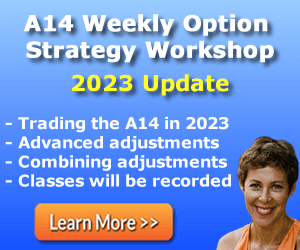Some traders are of the mindset of “what good is backtesting if it doesn't always replicate real-life trading?”
It's true that backtesting isn't the same as live trading. It doesn't recreate all the emotions and the market conditions such as low-volume days when you just can't get a decent fill, news events that can cause erratic market behavior intra-day, etc. However, what backtesting does do is to allow you to keep trading a workable trade during a period of draw-downs and be confident that overall, the trade is profitable. backtesting gives you a track record that instills confidence in your trade plan.
What else does backtesting do for you?
- Backtesting could keep you from abandoning your trade plan.
- Backtesting could help you from over-adjusting because your testing results confirm your adjustments as planned have a higher probability to work as intended.
- Backtesting could prevent you from jumping around from one trade to another.
- Backtesting could give you confidence in a new trade strategy, or in an existing strategy when considering increasing the size of the position.
- Backtesting could minimize the paralyzing insecurity that sometimes accompanies the switch from paper trades to live trading.
What if you don't have backtesting capabilities?
If you don't have backtesting capabilities, almost all brokerage platforms allow you to reset certain parameters in your trade or a simulated trade setup looking. This allows you as a trader to look at possible future results you may encounter as the trade matures. This may include rolling implied volatilities up or down, changing the date, or changing the price. If you are a trader without backtesting capabilities, you could test your trades in this manner if your platform has the capability to determine how it might act theoretically in certain market conditions looking into the future. You could follow a trade through each expiration cycle on a simulated basis. You as a trader could also simulate several expiration cycles, always pre-testing how certain adjustments might work. Then these simulated adjustments can be monitored with your live position to determine if they worked as predicted in your simulation.
So, how does your backtesting and simulating trades relate to live trading?
Don't underestimate the importance of your trading style and confidence level when evaluating a back-tested trade. A good result of your back-test can make your trade plan mechanical, as much as possible. By becoming more mechanical due to your backtesting, your experience will allow you to act as your trade plan dictates, making the necessary adjustments to your trade at the proper moments.
You can't replicate all the hurdles of live trading with either backtesting or forward-testing, but it all helps. It's about building confidence in your trade. Your confidence can help you follow your trade plan and guidelines. This confidence can allow you to enter, make appropriate adjustments if needed and exit your trade as planned in your live position.
The quote below can be related to the benefits of backtesting:
In summary, whether you have a backtesting program or use your broker's simulated trade capabilities, test, test, test. Test a lot. Testing can help identify potential pitfalls and potholes. However, it's important to be aware that when you're ready to make the switch to live trading, that testing can act somewhat like sunlight on rain-slicked roads. All that shiny sunlight can bounce off the water, covering a pothole that can cause you to veer off course. Don't speed into live trades too quickly; drive carefully until you're feeling certain of the surface beneath you.
I hope this article gives some insight to the benefits of backtesting. Feel free to comment below.


